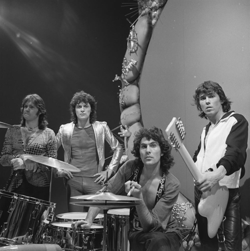Golden Earring | |
|---|---|
 Golden Earring in 1974 left to right: Rinus Gerritsen, Barry Hay, Cesar Zuiderwijk, George Kooymans | |
| Background information | |
| Also known as |
|
| Origin | The Hague, Netherlands |
| Genres | |
| Works | Discography |
| Years active |
|
| Labels | |
| Members | |
| Past members |
|
| Website | goldenearring |
Golden Earring are a Dutch rock band, founded in 1961 in The Hague as the Tornados. They achieved worldwide fame with their international hit songs "Radar Love" in 1973, which went to number one on the Dutch chart, reached the top ten in the United Kingdom, and went to number thirteen on the United States chart, [3] [4] "Twilight Zone" in 1982, and "When the Lady Smiles" in 1984. [3] During their career they had nearly 30 top-ten singles on the Dutch charts and released 25 studio albums.
Contents
- History
- Early years (1961–1969)
- International fame (1970s and 1980s)
- Later years (1990s–2021)
- Reunion and death of George Kooymans (2025–present)
- Band members
- Current members
- Former members
- Session musicians
- Lineups
- Timeline
- Discography
- References
- Sources
- External links
The band went through a number of early personnel changes until settling on a stable lineup in 1970, consisting of Rinus Gerritsen (bass and keyboards), George Kooymans (vocals and guitar), Barry Hay (vocals, guitar, flute and saxophone), and Cesar Zuiderwijk (drums and percussion), which remained unchanged until the band broke up in 2021 when Kooymans was diagnosed with ALS. A number of other musicians also appeared in short stints with the band over its history. As of Kooymans' death in 2025, Gerritsen is the only surviving original member.
The band is scheduled to play a series of five farewell concerts at the Rotterdam Ahoy in 2026.


